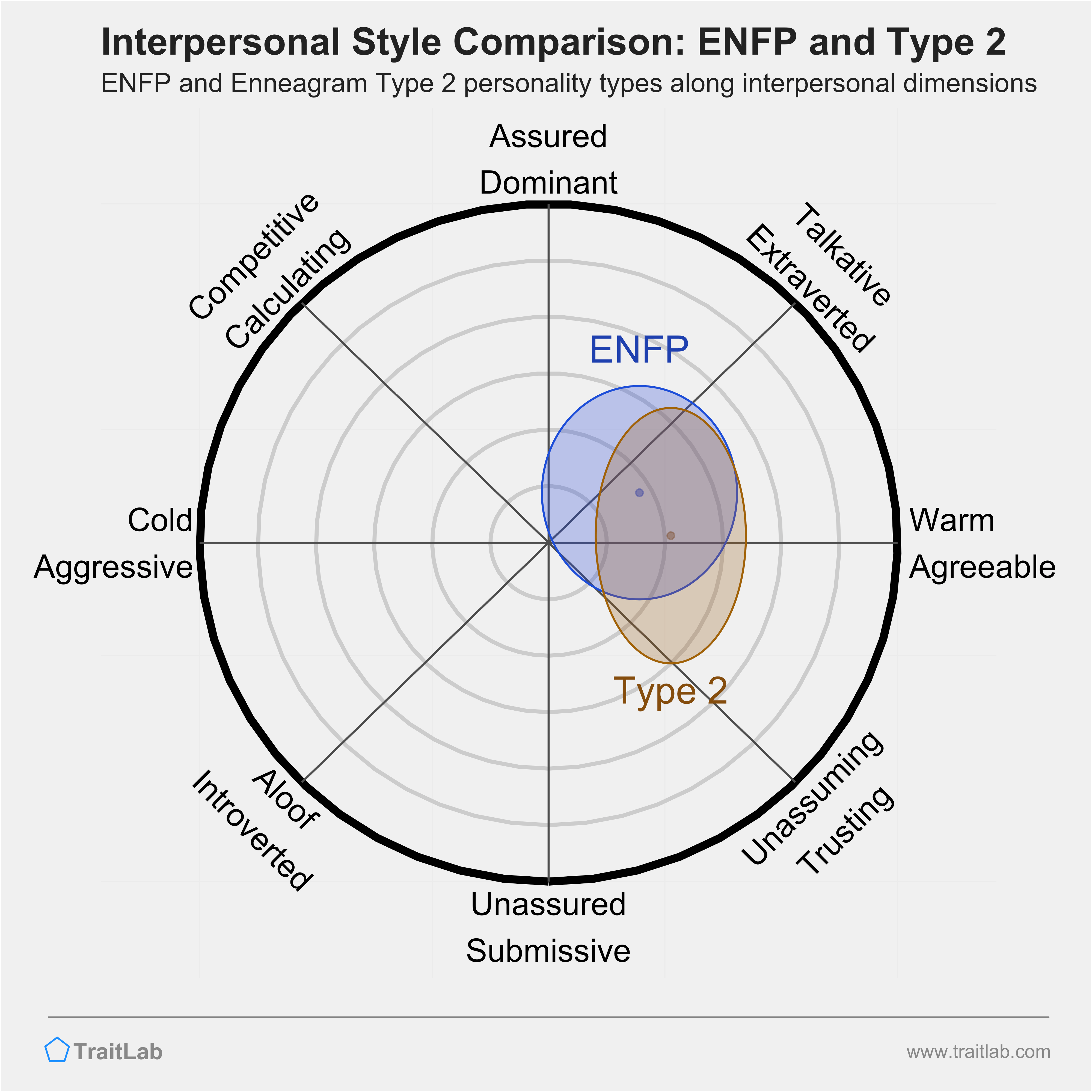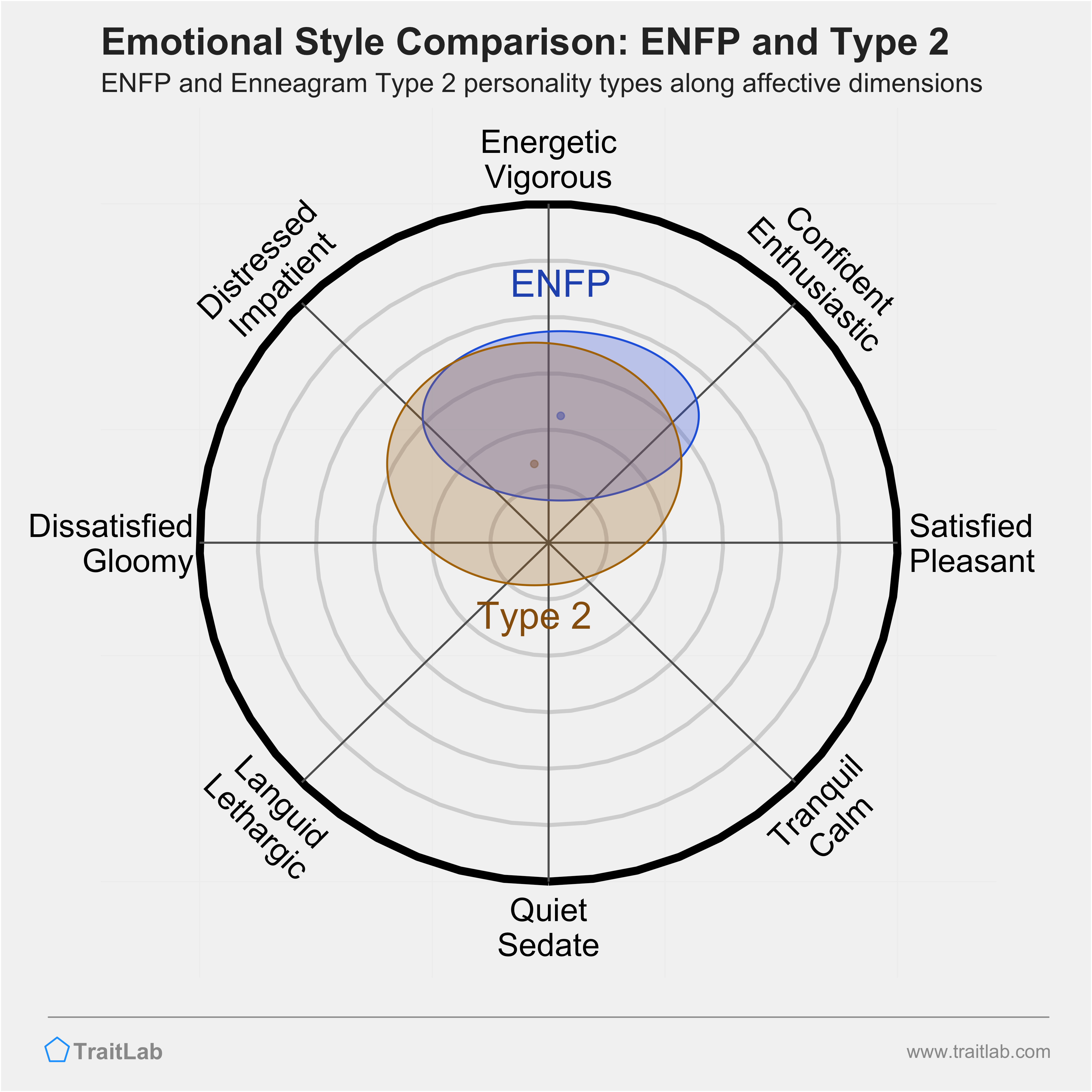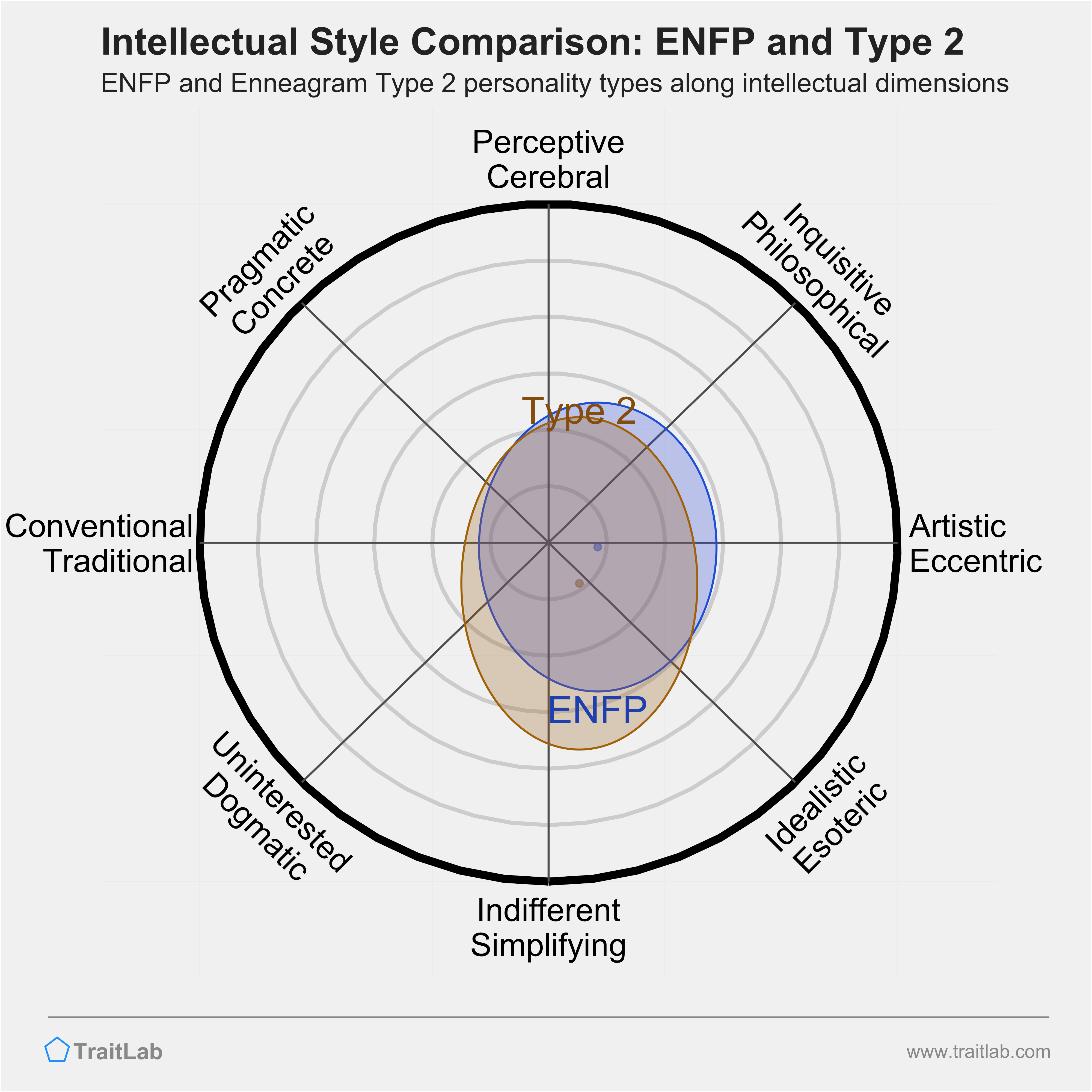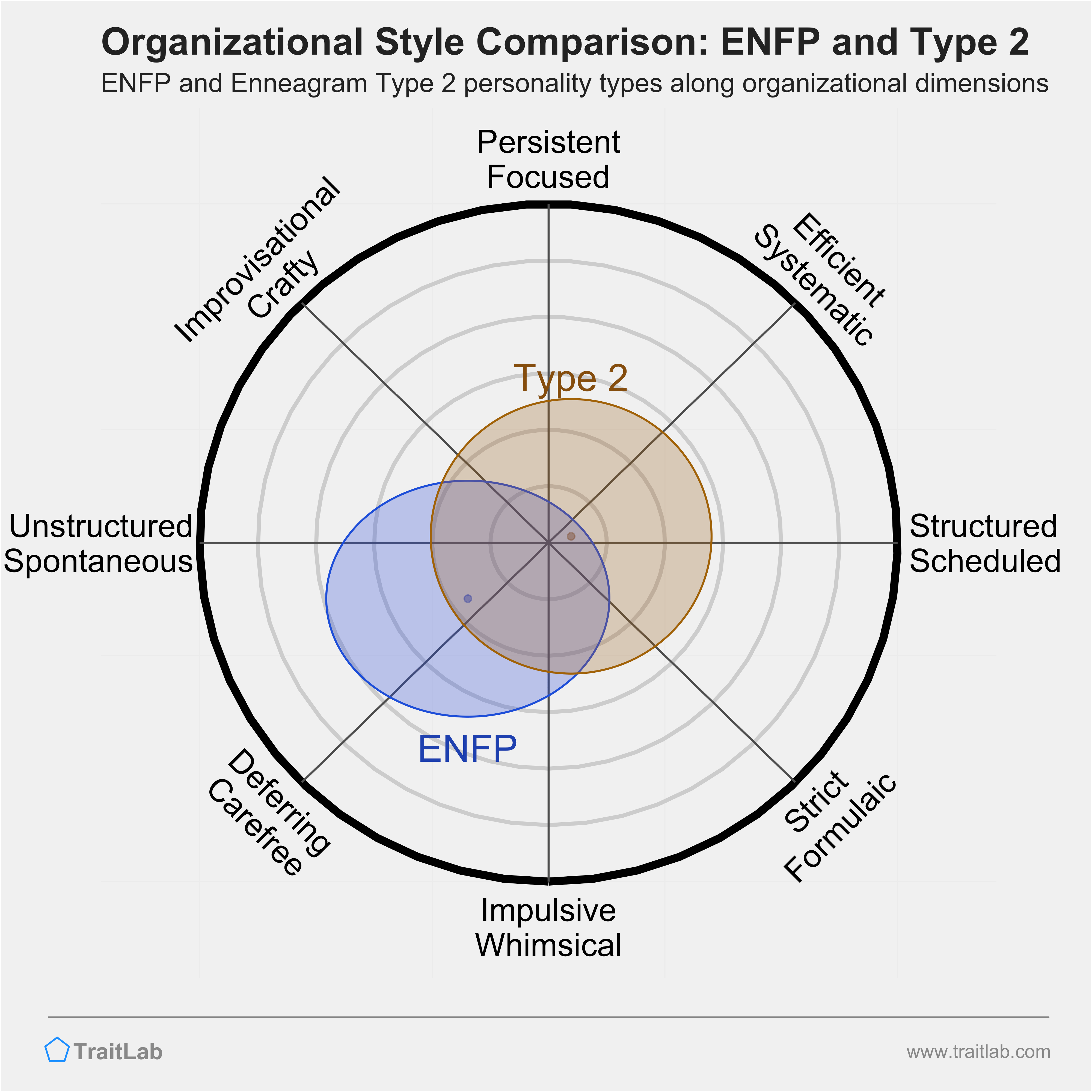How compatible are the ENFP and Enneagram Type 2 patterns of communicating, feeling, and thinking?
Reading time: 5 minutes

Gregory Park, Ph.D.
Author
In this article, you’ll find comparisons of two personality types — ENFPs and the Enneagram Type 2s — across four important personality domains: Interpersonal/Communication Style, Emotional Style, Intellectual Style, and Organizational Style.
TraitLab collected data about personality traits from thousands of participants who identified as a particular type from the 16 Personality or Enneagram typology.
For each comparison area below, you’ll see show the average similarities and differences between ENFPs and Type 2s. While these comparisons are useful for understanding broad trends across these types, it’s important to remember that all personality types are oversimplifications. For an assessment of your unique personality, you’ll want to use an assessment that goes beyond single personality types.
Jump to any section with the links below.

Do you know your personality type?
Learn about your type and so much more with TraitLab's comprehensive personality assessment.
Your particular style of communicating and interacting with others can be described fairly well by two dimensions: assertiveness and warmth.
Assertiveness describes your tendency to assert yourself, lead, and influence others in social situations, while warmth describes your tendencies to empathize and put others’ needs ahead of your own.
People with the same personality type often share some similarities in assertiveness and warmth. In the graph below, you can see where most ENFPs and most Type 2s fall along both of these dimensions.
First, take a look at where people in each type, on average, fall in this interpersonal space.

ENFPs often support, openly sympathize, and actively offer help to others At their best, they are gentle sympathizers, who are easily trusted and accepted. ENFPs may be overly revealing and have difficulty being alone. At their worst, they can require too much attention and admiration from others and be excessively involved in the affairs of others.
Type 2s often agree, trust, and cooperate with others. At their best, they are friendly, affectionate, and bring out the warmth and sympathy in others. Type 2s may be too agreeable and quick to compromise. At their worst, they may seek approval and agreement too much, and be dependent on the approval of other people.
One aspect that you and many Type 2s have in common in their interpersonal warmth. Both ENFPs and Type 2s tend to be on the friendlier side and are attentive to the needs and interests of other people, sometimes at the expense of your own goals.
Likewise, you and most Type 2s both tend to be more assertive and dominant in social situations. You are both managing, directing, and leading others, and feel comfortable taking the lead. This may lead you to butt heads with some Type 2s, because at times, you can both be domineering or overly direct.
Another characteristic of your personality is your emotional style — your tendencies towards different kinds of moods. There are two dimensions that influence emotional style: arousal and valence.
Arousal describes your relative energy level across different situations. Those with high baseline levels of arousal tend to be generally more alert, active, and engaged, while those with a lower baseline are more reserved, subdued, and inhibited.
Valence describes whether these moods tend to be positive (pleasant) or negative (unpleasant). People with a more positively valenced style are more likely to experience emotions like joy, enthusiasm, satisfaction, and serenity. People with a more negatively valenced style are more likely to experience sadness, frustration, dissatisfaction, and anxiety.
The graph below shows where each type, on average, usually sits in this emotional space.

ENFPs tend to be energetic and enthusiastic across most situations. They take on new challenges with excitement, confidence, and a sense of adventure. ENFPs are usually more optimistic than most people, and they generally feel like they can handle what life throws at them.
Type 2s tend to be tense, concerned, and vigilant in many situations. They usually have a pessimistic outlook and are often looking for what could go wrong next. Type 2s are highly active and tend to juggle many tasks. When things go wrong, this energy can turn into frustration and impatience, and they are more likely to express their dissatisfaction to others.
Like most ENFPs, you and many Type 2s share a relatively high energy level. You both prefer to be in motion, actively engaged in something interesting, rather than sitting back and observing. In the best case, the two of you feed off the other’s energy and excitement, and there’s rarely a quiet moment when you’re together.
One difference between ENFPs and Type 2 is in their typical emotional valence, which describes tendencies towards positive or negative emotions. You and most ENFPs tend to fall on the more positive side. Compared to most Type 2s, you and most ENFPs experience positive emotions such as joy, satisfaction, and happiness more often than most Type 2s. Type 2s have the opposite pattern, and they tend to gravitate towards more negative emotions.
These subtle emotional differences often surface in your reactions to new information. The same news that sparks enthusiasm in you and most ENFPs can induce worry in Type 2s. Compared to ENFPs, most Type 2s may need additional time and space to recover from stress.
Your intellectual style describes how you receive, process, and pursue different kinds of information. Differences in intellectual style are captured well by two dimensions: ideas and aesthetics.
Ideas describes your appetite for new information and your interest in complex, challenging material. People high on the ideas dimension have an appreciation for complexity and technical details. People lower on ideas are less interested in learning for learning’s sake, and they prefer to simplify complex topics down to the essential details.
Aesthetics captures your relative interest and sensitivity to aesthetic information and its emotional impact. People higher on the aesthetics dimension usually have strong artistic interests and a deep appreciation for beauty in many forms. Those lower on aesthetics tend to value practical application over artistic merit and usually adhere to more conventional standards of beauty.
In the graph below, you’ll see where ENFPs and Type 2s, on average, fall in this intellectual space.

Most ENFPs and Type 2s overlap heavily in their intellectual style.
ENFPs and Type 2s are idealistic, creative dreamers. They tend to be interested in the nuances of emotional and artistic experiences, looking for patterns and meaningful insights. ENFPs and Type 2s are comfortable with ambiguity and abstract concepts, focusing on the big picture rather than technical details. They often practice some form of creative expression and are likely to hold a few unconventional, eccentric beliefs.
As a ENFP, you and most Type 2s are down-to-earth, straightforward thinkers. You’d both prefer to stick to the essentials and focus on practical issues, and you try to avoid overcomplicating matters. When you and your Type 2 counterpart are together, your conversations are more likely to revolve around concrete details, facts, and conventional topics rather than theoretical or philosophical ones.
Likewise, both ENFPs and Type 2s share a deep appreciation for beauty in the natural and artistic world. Both of you can easily become absorbed in aesthetic experiences and overcome with a sense of awe and wonder. The two of you can find common ground in your love of creative expression and unconventional approaches to life’s challenges.
Your organizational style describes your habits around organization and planning. Your organizational style influences how you structure your time and physical space. Differences in organizational style fall along two dimensions: industriousness and orderliness.
Industriousness describes your persistence, need for achievement, and intensity of focus. People higher on industriousness usually organize their behavior around a few important long-term goals. People lower on industriousness are usually more focused on the present and will more easily change their focus when new opportunities appear.
Orderliness describes your need for regularity, order, and structure in your environment. People higher on orderliness prefer tidy, organized physical spaces, detailed schedules, and reliable routines. People lower on orderliness can tolerate more disorganization and prefer a more spontaneous, unstructured approach.
The graph below shows the average position of ENFPs and Type 2s along these dimensions of organizational style.

ENFPs thrive in unstructured environments with fewer constraints and more room for improvisation and serendipity. They generally focus on enjoying the present rather than preparing for the future. ENFPs highly value spontaneity and the flexibility to change their mind, and they resist setting hard deadlines or rigid expectations.
Type 2s are usually systematic and highly organized. They like setting big, long-term goals and then creating detailed plans to accomplish them. Type 2s are generally good at ignoring distractions and making steady progress through consistent routines and habits.
Like many ENFPs, you and most Type 2 often differ in your need to achieve explicit goals and use your time productively. While you embrace the here and now, your Type 2 counterpart is often thinking about and planning for the future. When you are keeping your eyes out for new, interesting opportunities, Type 2s are usually working away with their heads down. This difference between your present-oriented mindset and their future-oriented one can create occasional tension. However, this difference also helps you balance the other out at times. Your Type 2 counterpart often needs you to break them out of their need for productivity and efficiency while they can provide you with additional focus and motivation.
A second difference between ENFPs and Type 2s is in their relative need for routine, structure, and order. You and most ENFPs are more comfortable with an unplanned, spontaneous approach to life, while your Type 2 counterpart often wants plans, schedules, and well-defined procedures. Type 2s thrive on routine and predictability, whereas ENFPs find the same level of organization to be overbearing and constraining. These differences in tidiness, punctuality, and comfortability with deviating from social expectations can be a consistent source of conflict between the two of you.
Most people have complex personalities, and they don’t fit perfectly into a single personality type.
With TraitLab’s comprehensive analyses of your traits, strengths, and interests, you can see how your personality compares to every type from the Enneagram and 16 Personality typologies. Start building your personality profile by creating a free account today.
For comparisons between ENFPs and other Enneagram types, visit any of the type pairings below:
For comparisons between Type 2s and other types from the 16 Personality typology, visit any of the pairings below: